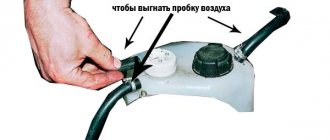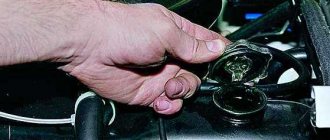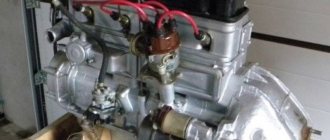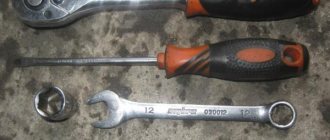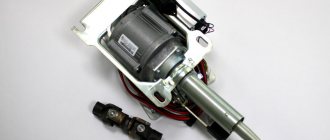The manufacturer AvtoVAZ recommends replacing the coolant at least once every two years or every 60,000 km. But it is possible that the antifreeze will need to be replaced earlier, if its composition has changed, it has changed in color, which may indicate poor quality and, as a result, corrosion in the channels of the cooling system. In order to replace antifreeze or antifreeze in the VAZ 2106 cooling system we will need:
- Wrench 13 regular or head with a knob
- Open-end wrench 12 (optional)
- Flat screwdriver
Procedure for draining coolant
First, you need to prepare a container for draining the antifreeze, preferably it should be at least 10 liters. First, you need to turn the heater (stove) control lever to the extreme right position, that is, at this moment the heater valve must be open completely so that the liquid from the heater radiator also drains.
Now you can start draining. Open the filler cap on the VAZ 2106 radiator:
After this, you can unscrew the plug from the cylinder block; it is located in the lower part on the left side of the engine. Its location is shown more clearly in the picture below:
And immediately place a container so that the old coolant drains into it. I used a couple of 1.5-liter bottles, alternately placing them in the hole:
When all the glass is here, you can turn off the tap in the lower left corner of the radiator:
If it does not turn away by hand, then you can use a key of the required size (12 in this case). After this, place a container under the hole and wait until all the liquid drains from the radiator:
As soon as all the liquid has been drained from the cooling system of the VAZ 2106, you can screw the plugs into the cylinder block and the radiator tap into place. And after that you can start replacing antifreeze (antifreeze).
First, pour liquid into the radiator until its level reaches the lower edge of the neck. Then we repeat the same with the expansion tank. To avoid the appearance of air locks in the cooling system, it is necessary to pour antifreeze in a thin stream. To prevent a plug from forming in the expansion tank hose, you need to raise the tank above the engine, having first removed it from the clamp:
Antifreeze VAZ 2106
Coolant regulates many important processes in a car. For example, it cools the motor, it affects the temperature sensor and its indicators (during normal operation, the indicator should be at a low level). And in order to maintain all these processes normally, the VAZ 2106 antifreeze must be replaced on time.
How many liters do you need
9 liters, with expansion tank 10 liters.
How to drain
Stage one - draining the antifreeze from the radiator.
You need to unscrew the plug that covers the radiator neck (antifreeze is poured through it) and place a container under the radiator. In its lower part there is a drain plug, which should be unscrewed slowly (so that drops of antifreeze do not fall on the car components). If a VAZ 2106 is an early model and has an old radiator, it is impossible to find such a plug (because it does not exist). But there is a special sensor that activates the fan. This is what needs to be unscrewed with a 30 mm wrench.
Stage two - draining antifreeze from the engine block
To gain access to the drain plug located on the power unit block, you need to remove the ignition module. The plug is unscrewed using a 13 mm wrench. At the end of the draining, carefully tighten the plugs and wipe the car components with a rag, and also release excess air from the cooling system. This is done quite simply - the clamp clamp is loosened with a screwdriver, and the rubber hose is removed from the intake manifold.
How to remove the pump follow the link.
How to fill
Before you start draining the old coolant, you need to move the heating valve control lever inside the car to the extreme right position (the valve is open). Unscrew the expansion tank cap and the radiator filler cap.
In the lower left corner of the radiator we find the drain plug, unscrew it and drain the liquid into a previously prepared container. On old-style radiators there is no such plug. Instead, using a 30 key, you will have to unscrew the fan switch sensor. Also on the engine block, we find it and use a 13 key to unscrew the drain plug. After the liquid has been drained, screw the drain plugs into place.
Coolant Application
- To maintain normal temperature (sensor) during engine operation.
- To maintain a low temperature (sensor) in the gearbox.
- For lubricating the water pump located in the engine.
- For heating the interior in winter cold.
Replacing antifreeze or antifreeze in a VAZ 2106 car should be done every 45 thousand km or once every two years, depending on the circumstances. Replacement must be made because this substance, like many others, loses its properties over time and succumbs to corrosion. In order to avoid this, you need to change it in time.
How to change coolant
Before replacing the coolant, you need to figure out how to fill it correctly, where, what quantity is needed and what brand. The draining and filling of this substance occurs in the expansion tank, which is located in the engine compartment on the left side of the mudguard on a bracket and secured with clamps.
Temperature sensor locations
You will need a volume of 10 liters of antifreeze or antifreeze. Which is better for you? According to reviews, the first one slightly exceeds the indicators; it is also sold in a ready-made form, or it needs to be diluted in a simple proportion (50 to 50). Choose a high-quality and reliable brand.
Six system diagram
It must be said right away that it consists of two circuits - small and large. Look at the photo and pay attention to the arrows, they indicate in which direction the antifreeze is moving. 2106 is not the only model with a similar circuit; all classics have similar system designs. It is necessary to make a reservation: antifreeze and antifreeze are one and the same thing. In fact, antifreeze is a brand of antifreeze, and it differs from the one you are used to seeing only in the quantity and quality of additives. Tosol is a Soviet designation for antifreeze.
Thermostat operation at different antifreeze temperatures
If we go into detail and decipher the word “antifreeze”, then it can be literally translated – “against the cold”. It is a liquid that does not freeze. Vodka is also antifreeze. It just doesn’t contain the necessary additives. Well, okay, enough of the ranting, we still need to figure out what the cooling circuit of the VAZ 2106 consists of. So, let's start from the very beginning. You come to your car in the morning, sit behind the wheel and start the engine. At this moment, the liquid in the system begins to forcefully move in a small circle.
Pump 2106 makes the liquid move. Its price in stores is about 700 rubles. But this is only a cover with an impeller. We'll look at the detailed design below. Now your engine is running, warming up, and flashes occur in the combustion chambers. As a result, the surface of the cylinders heats up to a high temperature. But all the heat is transferred to the liquid, which flows through the engine cooling jacket.
And when it warms up to a temperature in the range of 80..85 degrees, the VAZ 2106 thermostat comes into operation, its price is around 400 rubles. It closes the circulation in the small circle and releases antifreeze in the large circle. A large cooling circle is the inclusion of one additional unit in the circuit - a radiator. It is worth mentioning that fluid circulates through the heater radiator constantly, regardless of the position of the thermostat valves.
Expansion tank six
And if antifreeze boils in the expansion tank of a VAZ 2106, then we can assume two breakdowns - failure of the thermostat or pump. In most cases, of course, the thermostat is to blame. This device is very delicate and fragile, and inside the cooling system there is usually so much debris that settles on the surface of the thermostat valves. And if it breaks, the liquid circulates in a small circle without getting into the cooling radiator. And here it doesn’t matter at all whether you are driving in a traffic jam or on the highway at normal speed. The antifreeze will still boil.
Drain
To get started, make sure you have all the necessary tools:
- key or head;
- screwdriver;
- container for draining;
- stock of new coolant.
Removing the radiator cap
If your engine is cool, you can start working right away.
- Park the car on a level road.
- Open the hood and remove the radiator cap.
- Unscrew the cap from the tank.
- Place a container for draining (one that can hold at least 5 liters).
- Unscrew the bolt and also the radiator cap. Now you can drain everything.
Fill in
If the first part of the procedure was successful, then you can safely proceed to the second.
- Tighten the bolt.
- Fill the radiator with the required amount of antifreeze or antifreeze.
- Remove the hose and let the substance flow into it so that it flows out the other side. Lift the tank, insert the hose and pour in completely.
- Turn on the engine before the fan starts.
- Turn it off and check the sensor and level.
- Now tighten the radiator cap and tank cap. Screw on the cap and close the hood.
Done, the replacement in the VAZ 2106 was completed successfully.
Pour liquid into a special hole
Procedure for replacing antifreeze
Coolant replacement steps:
Check the sensor, which is responsible for the qualitative and quantitative indicators of antifreeze in the system.
Drain off any remaining old antifreeze. To do this, you need a container into which the waste material will drain.
Make sure that the engine has completely cooled down, because if this does not happen, you can easily get a serious burn.
Place the car on a slope to better drain all unnecessary liquid.
Unscrew the plugs and bolts from the radiator and expansion tank.
Be sure to rinse the entire system several times with water or special products. This is primarily necessary when you want to use another type of cooler.
Fill with new antifreeze and turn on the engine. Let it work for a while.
If possible, check the selected fluid against the vehicle manufacturer's specifications and service intervals.
Is it possible to fill
Very often, car enthusiasts do not pay due attention to the coolant in the engine cooling system, and in most cases, not only do they not change the coolant at all, but they do not even know what exactly is poured into the engine cooling system of their car. Such carelessness is in vain. After all, further maintenance of the entire vehicle depends on the correct choice between antifreeze and antifreeze. And so, let's figure out which is better - antifreeze or antifreeze.
This division of coolants into antifreeze and antifreeze exists only in Russia. The origin and history of TOSOL have already been repeatedly described in various media. According to Arteco, up to 22% of all breakdowns are directly, and 40% are directly or indirectly related to the engine cooling system. Therefore, paying proper attention to cooling and choosing the right coolant can help save money and time.
The composition of lubricating coolants includes mixtures of ethylene glycol (occasionally containing mixtures of propylene glycol), water and a whole package of corrosion inhibitor additives. Coolants from different manufacturers differ from each other precisely in the production technology of the additives included in their composition.
When choosing a lubricating coolant for your car, first of all you need to study its operating manual or service book to find out the recommendations of the car manufacturer and possible nuances of using a particular fluid known to the latter. In such a manual, the automaker can prescribe specific manufacturers and names of cutting fluids that have successfully passed all tests and tests (laboratory, bench, operational) conducted by the automaker, or prescribe the class of such fluids. These include liquids produced using one of the following technologies:
traditional - the composition includes additive packages based on salts of inorganic acids (nitrates, nitrites, borates, silicates, phosphates, amines);
carboxylate (OAT) – the composition includes additive packages based on salts of organic acids (carbonates);
hybrid – a type of carboxylate technology in which additive packages are created based on salts of carboxylic acids with minor additions of silicates and/or phosphates).
The Russian market is dominated by cutting fluids produced using traditional (antifreeze) and carboxylate (antifreeze) technologies.
Why does it flow
If the lubricant level in your VAZ 2106 car begins to decrease, then there is a high probability that a leak has occurred and before changing it, you need to “patch” the leak site. Finding it is sometimes not very easy. Try searching in places like:
- clamps (it is possible that they are not clamped well);
- radiator (mechanical damage);
- pump (pump worn out);
- leakage from under the head;
- leak into the cabin.
In some cases, you will have to replace the part, in others you will just have to screw it in, seal it and weld it, but there are also cases when the matter requires serious repairs and you will have to take the car to a service center. Therefore, pay close attention to your car and monitor the level and temperature.
When to replace antifreeze
There are several general rules about updating the engine coolant, which help determine when exactly it is necessary to fill the VAZ tank with antifreeze:
- The car's mileage reached 60 thousand km;
- the machine ran on the same fluid for two years;
- change in color (mostly red).
Correct update sequence
It is important to know that to replace the coolant in a VAZ 2106 car you need to clearly and carefully perform a number of actions
. If one point is missed, the replacement will not only be useless, but can also lead to unwanted damage.
Replacement frequency, what antifreeze to fill
According to the manufacturer's recommendation, it is necessary to replace antifreeze or antifreeze on VAZ 2106 cars every 2 years or after a mileage of 60 thousand kilometers. If the car is used in more severe conditions, then it is advisable to replace it more often - every 30-40 thousand kilometers.
In addition to the recommended coolant change intervals, there are other reasons why it is necessary to change the fluid in a car's cooling system:
- Loss of properties. You can check the quality of the antifreeze used using a test strip, which is sold in the same places where the liquid itself is sold. Place the strip in the expansion tank, then pull it out. The strip comes with a color scale, according to which you can understand how much longer the car can be used before replacing the coolant.
- Change in color to red or red. This means that rust has appeared in the composition.
- The appearance of sediments, flakes and dense formations.
In all cases, it is necessary not only to replace, but also to check the entire engine cooling system for serviceability.
As a coolant for the VAZ 2106, you can use good Lukoil antifreeze. Or a lesser-known but high-quality product from Gazprom Neft. When replacing, you can also fill in antifreeze, preferably with G12 approval, it is safer for the entire system. You can also use original Lada G12 antifreeze, which is suitable for all cars of this manufacturer.
How much antifreeze is in the cooling system, volume table
Model Engine displacement How many liters of antifreeze in the system Original fluid / analogues VAZ 21061.69.8 Gazpromneft antifreeze Lukoil antifreezeTo drain old fluid
First, let's look at how to drain antifreeze from a VAZ 2106, which no longer copes with the cooling function of the system. You need to start by removing the crankcase protection and moving the warm air supply lever to the right side. The next step is to remove the radiator filler cap. Next, you need to remove the fluid drain plug located on the surface of the cylinders. Now you can safely pour the antifreeze into the previously prepared tank.
To fill in a new substance
In order to replace the antifreeze with a new one, you need to return the radiator tank to its original place and tighten the drain plugs and the neck of the part. After this, new coolant should be poured into the radiator and its expansion tank, but slightly more than the minimum mark. An equally important action is to neutralize all air pockets formed in the cooling system.
After closing the radiator, you can start the car and let it idle for about five minutes. After the engine has cooled down, it is necessary to add antifreeze to the maximum level.
.
Work order
Carefully!
It is necessary to replace the coolant only on a “cold” engine.
First of all, we will need to move the upper lever of the heater control system to the extreme right position, while opening the heater radiator valve.
Here, for convenience, you need to remove the engine splash guard.
Next, we find the expansion tank and remove the plug.
Carefully remove the cap from the radiator filler neck.
Gradually unscrew the plug that closes the drain hole. You will find the plug in the very bottom left corner of the radiator,...
...and drain the used coolant into a special container, which should be prepared in advance, the recommended volume is at least 8-10 liters.
Do not forget to drain the coolant from the connecting hose by removing the fastening of the expansion tank and lifting the latter.
The liquid will go first into the radiator and then into the container. Next, install the tank in place.
Move to the left side of the engine, find the drain plug on the cylinder block and, using a 13mm wrench, slowly unscrew it. The remaining liquid will flow out of the block.
Afterwards, screw the radiator cap back on and, most importantly, do not forget about the cylinder block cap.
That's it, the old fluid has been drained, now pour new coolant directly into the radiator.
During filling, air pockets may occur, and to avoid this, it is necessary to remove the rubber hose directly from the inlet pipe. When liquid appears, put the hose on the fitting.
When the radiator is completely filled, you need to wait a little (3-5 minutes) and, if necessary, add coolant. When the radiator is full, close it with the cap.
Also read - Replacing the ball joint VAZ 2106, 2107, 2109, 2110, 2114 with your own hands without a puller and with it.
Next, the remaining liquid must be poured into the expansion tank, so that the liquid is 2–4 cm above the indicative o.
When all the work is completed, start the car, warm up the engine to an operating temperature of 90°C (for VAZ 2106).
When everything is ready, we start the engine until it warms up to operating temperature. We remind you that the standard operating temperature of the VAZ 2106 engine is approximately 90°C.
At the same time, do not forget to monitor the fluid level in the tank and add fluid if necessary.
Source

